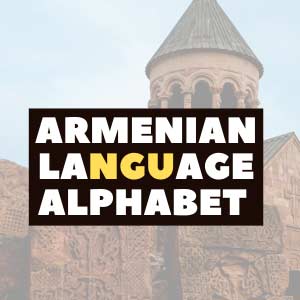Armenian Language alphabet speak in Armenia
Armenia language one of the oldest languages in the world, that have been spoken more than 16 century. The official language of Armenia is Armenian. It is the main language spoken by the majority of the population in Armenia nation. Armenian is an Indo-European language and has a unique script called the Armenian alphabet that includes 39 letters, which was created by Armenian monk Mesrop Mashtots.
Armenia has a rich history that dates back over 1,500 years. It is believed to have evolved from the ancient Armenian language, which was spoken in the region of the Kingdom of Urartu and Van. The language has gone through various changes and developments over the 16 century, influenced by neighboring languages and cultural interactions like Iran, and Georgia.
What is the Armenian language like ?
The Armenian language has its own distinct branches: Old classical Armenian (Grabar) and Modern Armenian (Ashkharhabar). Classical Armenian, also known as Old Armenian languages, was used from the 5th century until the 19th century and is primarily found in historical and religious texts.

What language is Armenian based on generally?
Modern Armenian, the form of the language spoken today, has two main dialects: Eastern Armenian and Western Armenian. Eastern Armenian is the official language of the Republic of Armenia and is spoken by the majority of Armenians worldwide. Western Armenian, which originated from historical Western Armenia (now part of Turkey), is spoken by the Armenian diasporas and has some differences in vocabulary and pronunciation compared to Eastern Armenian.
Do Armenia the oldest language?
The Armenian language is an important part of the cultural identity of Armenia and plays a significant role in literature, music, and other art forms. It is also taught in schools and universities throughout the country.
We don’t forget that the English renowned poet Byron said that the Armenian language is a language for communication whit God. “God spoke to the people in Armenian”.
How many letters are in the Armenian alphabet?
The Armenian language alphabet was created by the Armenian linguist, monk and theologian Mesrop Mashtots and his students in the early 5th century AD. Mashtots created the Armenian alphabet, known as the «Mashtotsian alphabet,» which consisted of 36 letters. This alphabet played a crucial role in the preservation and development of the Armenian language and history.
Once the Armenian alphabet was created, the translation of religious texts became one of the primary focuses for Mesrop Mashtots and his students. The first known translation into Armenian was the Bible, specifically the translation of the Christian scriptures. This translation, known as the «Armenian Bible» or the «Armenian Version,» was completed around the 5th century AD.
Besides religious texts, Armenian literature also emerged and developed throughout the centuries. Some notable early Armenian literary works include the «History of Armenia» by Movses Khorenatsi, the gretast Armenian historian which dates back to the 5th century, and the works of the poet Grigor Narekatsi, particularly his renowned mystical poem, «The Book of Lamentations» (also known as «Book of Sorrows» or «Narek»).
Which is Armenian language family tree ?
The Armenian language belongs to its own branch within the Indo-European language family. It is classified as an independent branch of the family, meaning it does not belong to any of the major branches such as Germanic, Romance, Slavic, or Indo-Iranian.

Armenian is primarily spoken in the country of Armenia, where it is the official language. Armenia is located in the South Caucasus region of Eurasia, bordered by Turkey, Georgia, Azerbaijan, and Iran. The majority of the population in Armenia speaks Armenian as their first language. However, Armenian is also spoken by significant communities in several other countries and regions. These include:
- 1. Nagorno-Karabakh: A region in the South Caucasus.
- 2. Armenia’s neighboring countries: There are sizable Armenian communities in neighboring countries such as Georgia, Iran, and Turkey.
- 3. Diaspora communities: Armenians have established communities around the world due to historical migrations. Large Armenian diaspora populations can be found in countries like Russia, the United States, France, Lebanon, Syria, Argentina, and many others.
Eastern Armenian and Western Armenian language
It’s worth noting that there are two main dialects of Armenian: Eastern Armenian and Western Armenian. Eastern Armenian is the official language in Armenia and is spoken by the majority of Armenians. Western Armenian is primarily spoken by the Armenian diaspora communities and is based on the historical dialects spoken in the regions that are now part of Turkey and were home to large Armenian populations before the Armenian Genocide in the early 20th century.
Where does Armenian language originate from?
The Armenian language belongs to its own branch within the Indo-European language family. The exact age of the Armenian language is difficult to determine precisely, but it is generally believed to have emerged as a distinct language around the 5th century BCE.
Earliest known evidence of the Armenian language comes from inscriptions dating back to the 5th century BCE. These inscriptions were discovered in the area known as the Kingdom of Urartu and Van, which covered parts of modern-day Armenia, Turkey, and Iran. The Urartian Kingdom was a regional power during that time, and the inscriptions indicate that the Armenian language was already established and used for administrative and ceremonial purposes.
Armenian language continued to evolve and develop over the 16 centuries. The earliest surviving literary texts in Armenian date from the 5th century CE, including translations of the Bible and other religious works. These texts played a crucial role in the preservation and standardization of the Armenian language and for Armenians.
